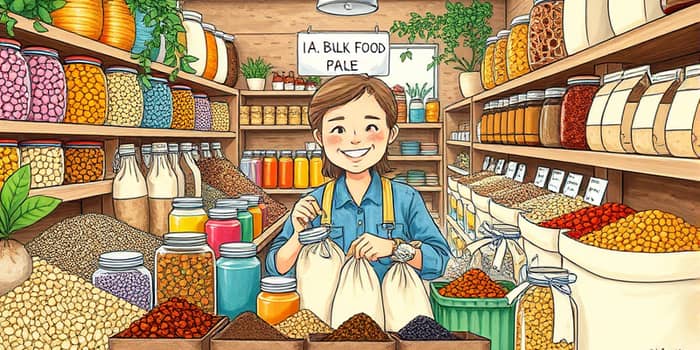Zero-waste shopping is more than a trend; it is a conscious lifestyle choice that invites individuals to reimagine their relationship with everyday purchases and their impact on the planet.
Understanding the Zero-Waste Philosophy
Rooted in practices that echo pre-plastic shopping habits and traditions, zero-waste shopping centers on purchasing loose goods, refilling personal containers, and opting for reusable alternatives over disposables. This approach seeks to minimize single-use packaging and waste, encouraging consumers to evaluate needs versus wants with intentionality.
Types of Stores and Where to Shop
One of the first steps in adopting zero-waste shopping is identifying outlets that align with this philosophy. Here are the primary options available in most regions:
Bulk food stores offer self-serve bins containing grains, nuts, legumes, spices, and snacks. Patrons bring their own jars or cloth sacks, weigh them, then refill directly from the dispensers. This model reduces packaging while often delivering more affordable wholesale-style pricing on staple ingredients.
Farmers’ markets are another excellent venue, featuring fresh produce that is typically unfettered by plastic wrapping. Because goods are sourced locally and seasonally, shoppers can enjoy superior taste and nutritional value at competitive prices.
Dedicated zero-waste shops carry a broader spectrum of items, from dry goods to household cleaning refills and body care essentials. These establishments often stock beeswax wraps, cloth produce bags, and refill stations for detergents, allowing patrons to stock up on everyday necessities sustainably.
Conventional supermarkets have begun to join the movement by introducing bulk sections or permitting the use of personal containers in deli, meat, and produce aisles. Even small steps by large chains can help consumers embrace sustainable and mindful purchasing habits without extensive travel or cost.
Practical Steps to Launch Your Zero-Waste Journey
Transitioning to a zero-waste shopping routine can seem daunting at first, but by breaking it into manageable tasks you can build momentum and confidence. Below are six actionable steps to guide you:
- Plan meals and craft a precise grocery list to avoid impulse purchases and buy only what you truly need.
- Accumulate and sterilize reusable containers—glass jars, cloth sacks, silicone tubs—and label each with its tare weight.
- Visit a bulk store or zero-waste shop. Before filling, use the provided scales or ask staff to weigh your empty container.
- Compare unit pricing (per 100g or per ounce) between bulk items and packaged equivalents to ensure you are getting the best deal.
- Prioritize seasonal, local produce for superior taste and to reduce overall environmental footprint substantially.
- Keep unused containers in your car or near your front door so you never forget them when grocery shopping.
Calculating Savings and Tracking Progress
Beyond environmental benefits, zero-waste shopping can deliver meaningful financial rewards. Anecdotal reports suggest households can save up to $2,000 annually by eliminating unnecessary packaging and optimizing bulk purchases. Digital tools and community apps like Olio, Too Good To Go, or Flashfood can help you find discounted surplus foods, further amplifying your savings.
Keeping a simple spreadsheet or journal can help you monitor both your waste reduction and dollar savings as you progress.
Budget-Friendly Tips for Zero-Waste Beginners
Many believe that zero-waste shopping demands a hefty upfront investment, but with strategic planning and resourcefulness, you can start small and scale up:
- Repurpose old jars, tins, and containers instead of buying new ones.
- Look for community groups or co-ops offering bulk purchases at wholesale rates.
- Purchase secondhand or discounted zero-waste essentials like metal straws, cloth napkins, or silicone bags during sales events.
- Use price comparison websites to vet the best places for specialty zero-waste items.
By beginning with one product swap at a time—such as replacing paper towels with reusable cloths—you can lower your long-term living costs dramatically while reducing your environmental footprint.
Overcoming Common Barriers
Not every region boasts specialty zero-waste shops, and the initial ritual of weighing and labeling containers may feel time-consuming. However, many conventional retailers now welcome eco-friendly practices. If a store lacks a bulk section, politely ask management about future plans or suggest a pilot program. Small changes can ripple outward, inspiring broader institutional shifts.
Moreover, the perceived obstacle of cost can be dismantled through mindful purchasing. By resisting impulse buys and focusing on essentials, you naturally avoid food spoilage and wasted spending. Even if you must acquire reusable items like glass jars, the long-term dividends in both savings and sustainability are unequivocal.
The Wider Impact and Community Engagement
Zero-waste shopping belongs to a global movement that champions closed-loop delivery systems. Many suppliers and shops have implemented packaging take-back programs, container swaps, and refillable shipping containers to circumvent single-use waste streams.
Engaging with local groups, online forums, or community workshops can both deepen your knowledge and foster local resilience. Shared initiatives—such as neighborhood container libraries or co-op bulk buys—illustrate that every small step contributes to lasting change.
Your Zero-Waste Shopping Starter Kit
Gathering basic tools before your first zero-waste expedition will set you up for success. Below is a concise list to begin your journey:
- Assorted glass jars with lids (various sizes for grains and liquids)
- Reusable produce bags made of mesh or cotton
- Cloth sacks or canvas totes for bulk refills
- Silicone storage containers or beeswax wraps for perishables
- Refillable bottles for cleaning and personal care products
With these items in hand, you can confidently explore bulk stores, farmers’ markets, and emerging zero-waste shops, knowing you are well-equipped to succeed.
Conclusion: Embrace Incremental Progress
Zero-waste shopping is not about instantaneous perfection but rather about cultivating mindful habits over time. Each jar you refill, every cloth bag you reuse, and each local purchase you make adds momentum to a movement that prioritizes people and the planet over single-use convenience.
Begin with small, intentional steps: plan your meals, gather containers, and familiarize yourself with local bulk offerings. As you adapt, you will uncover deeper savings, forge meaningful community connections, and experience the profound satisfaction that comes from aligning your purchases with your principles. In this journey, every ounce of effort propels us closer to a cleaner, healthier, and more sustainable world.
References
- https://www.partykitnetwork.org/post/a-beginner-s-guide-to-shopping-at-a-zero-waste-store
- https://greenchoicelifestyle.com/zero-waste-grocery-shopping-guide-list/
- https://emilylightly.com/2020/01/a-beginners-guide-to-low-waste-grocery-shopping/
- https://www.be-the-story.com/en/environment/the-beginners-guide-for-zero-waste-shopping/
- https://sustainlifejournal.com/how-to-shop-at-a-zero-waste-store/
- https://thrivingsustainably.com/zero-waste-grocery-shopping-tips/
- https://ecocart.io/zero-waste-grocery-shopping/
- https://daybring.com/stories/zero-waste-grocery-shopping/










